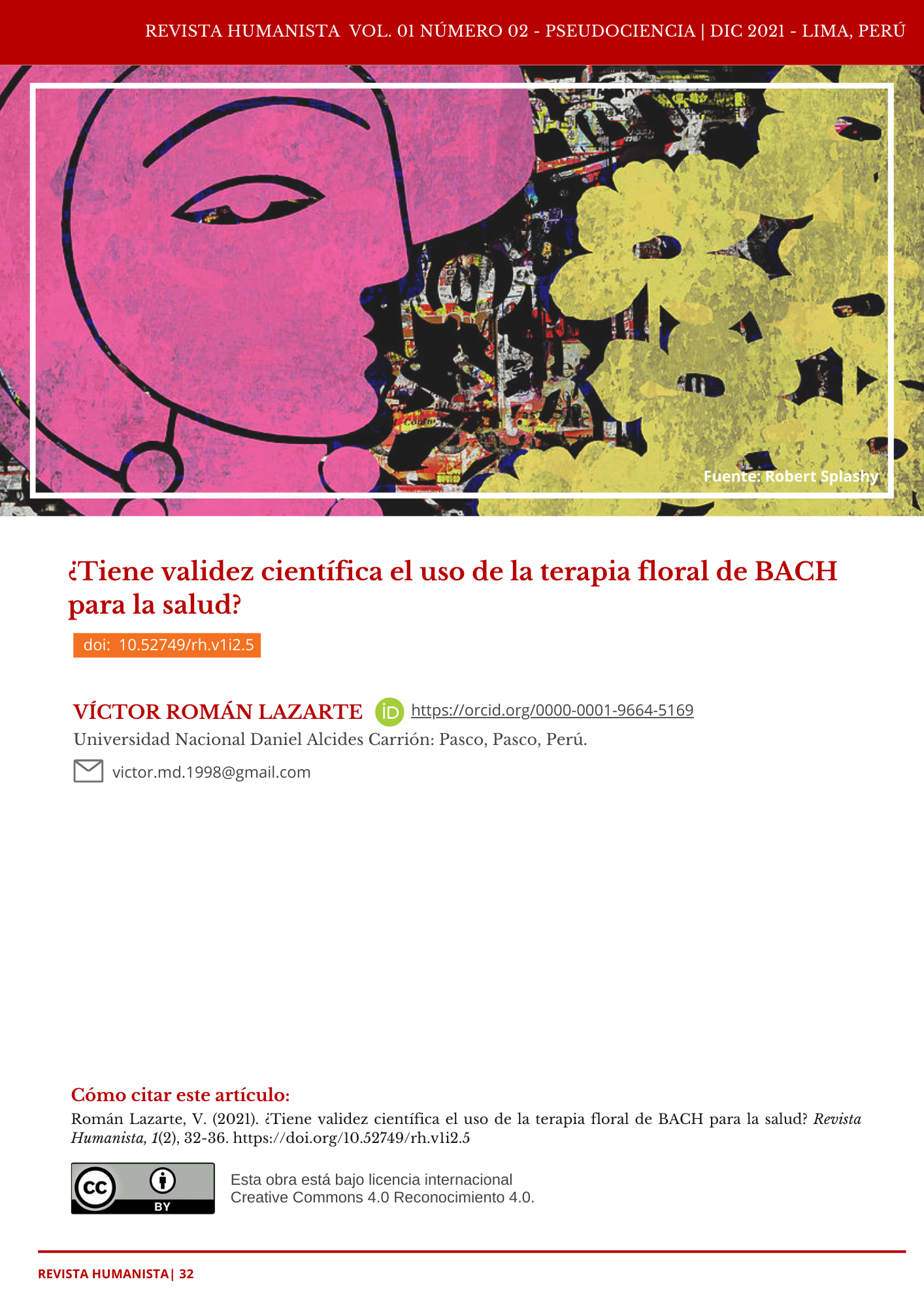¿Tiene validez científica el uso de la terapia floral de BACH para la salud?
DOI:
https://doi.org/10.52749/rh.v1i2.5Palabras clave:
Pseudociencias, Flores de Bach, Terapias florales, medicina alternativaResumen
La terapia floral o flores de Bach, se popularizó en la década de los 30’ gracias al médico homeópata Edward Bach. Este artículo tiene por objetivo revelar información científica basada en evidencias sobre la eficacia de la terapia floral mediante una revisión de literatura en diferentes bases bibliográficas.
Descargas
Citas
Balinski, A. A. (1998). Use of Western Australian flower essences in the management of pain and stress in the hospital setting. Complementary Therapies in Nursing & Midwifery, 4(4), 111-117. https://doi.org/10.1016/s1353-6117(98)80048-6
BOLETIN_MEC_JUNIO_2016.pdf. (s. f.). Recuperado 20 de junio de 2020, de http://www.essalud.gob.pe/downloads/BOLETIN_MEC_JUNIO_2016.pdf
Case study examples. (s. f.). The Bach Centre. Recuperado 20 de junio de 2020, de https://www.bachcentre.com/new/en/remedies/selecting-remedies/remedy-case-studies/
Ernst, E. (2002). «Flower remedies»: A systematic review of the clinical evidence. Wiener Klinische Wochenschrift, 114(23-24), 963-966.
Ernst, E. (2010). Bach flower remedies: A systematic review of randomised clinical trials. Swiss Medical Weekly, 140, w13079. https://doi.org/10.4414/smw.2010.13079
González-Méijome, J. M. (2017). Science, pseudoscience, evidence-based practice and post truth. Journal of Optometry, 10(4), 203-204. https://doi.org/10.1016/j.optom.2017.08.001
Howard, J. (2007). Do Bach flower remedies have a role to play in pain control? A critical analysis investigating therapeutic value beyond the placebo effect, and the potential of Bach flower remedies as a psychological method of pain relief. Complementary Therapies in Clinical Practice, 13(3), 174-183. https://doi.org/10.1016/j.ctcp.2007.03.001
Hyland, M. E., Geraghty, A. W. A., Joy, O. E. T., & Turner, S. I. (2006). Spirituality predicts outcome independently of expectancy following flower essence self-treatment. Journal of Psychosomatic Research, 60(1), 53-58. https://doi.org/10.1016/j.jpsychores.2005.06.073
Lucero, B. (s. f.). Terapias pseudocientíficas ofrecidas por EsSalud | Científicos.pe, Cientificos Peruanos. Recuperado 20 de junio de 2020, de http://www.cientificos.pe/index.php/2017/07/17/terapias-pseudocientificas-ofertadas-por-essalud/
Luján-Carpio, E., Lizarraga-Castañeda, Z., Mayor-Vega, A., Medrano-Canchari, K., Medina-Salazar, H., & Goicochea-Lugo, S. (2014). El servicio de Medicina complementaria de EsSalud, una alternativa en el sistema de salud peruano. Revista Medica Herediana, 25(2), 105-106.
Manterola, C., Asenjo-Lobos, C., & Otzen, T. (2014). Jerarquización de la evidencia: Niveles de evidencia y grados de recomendación de uso actual. Revista chilena de infectología, 31(6), 705-718. https://doi.org/10.4067/S0716-10182014000600011
Mantle, F. (1997). Bach flower remedies. Complementary Therapies in Nursing & Midwifery, 3(5), 142-144. https://doi.org/10.1016/s1353-6117(97)80015-7
Meza, G. S., Bardales, K. M., Cuenca, K. Q., & Trocones, I. S. (2019). La terapia floral en enfermedades orgánicas. Revista Peruana de Medicina Integrativa, 4(2), 64-68. https://doi.org/10.26722/rpmi.2019.42.122
Pintov, S., Hochman, M., Livne, A., Heyman, E., & Lahat, E. (2005). Bach flower remedies used for attention deficit hyperactivity disorder in children—A prospective double blind controlled study. European Journal of Paediatric Neurology: EJPN: Official Journal of the European Paediatric Neurology Society, 9(6), 395-398. https://doi.org/10.1016/j.ejpn.2005.08.001
Resende, M. M. de C., Costa, F. E. de C., Gardona, R. G. B., Araújo, R. G., Mundim, F. G. L., & Costa, M. J. de C. (2014). Preventive use of Bach flower Rescue Remedy in the control of risk factors for cardiovascular disease in rats. Complementary Therapies in Medicine, 22(4), 719-723. https://doi.org/10.1016/j.ctim.2014.06.008
Rivas-Suárez, S. R., Águila-Vázquez, J., Suárez-Rodríguez, B., Vázquez-León, L., Casanova-Giral, M., Morales-Morales, R., & Rodríguez-Martín, B. C. (2017). Exploring the Effectiveness of External Use of Bach Flower Remedies on Carpal Tunnel Syndrome: A Pilot Study. Journal of Evidence-Based Complementary & Alternative Medicine, 22(1), 18-24. https://doi.org/10.1177/2156587215610705
Thaler, K., Kaminski, A., Chapman, A., Langley, T., & Gartlehner, G. (2009). Bach Flower Remedies for psychological problems and pain: A systematic review. BMC Complementary and Alternative Medicine, 9, 16. https://doi.org/10.1186/1472-6882-9-16
The 38 Remedies Quick Reference Guide. (s. f.). The Bach Centre. Recuperado 20 de junio de 2020, de https://www.bachcentre.com/new/en/remedies/the-38-remedies/quick-reference-guide/

Descargas
Publicado
Cómo citar
Número
Sección
Licencia
Derechos de autor 2021 Víctor Román Lazarte

Esta obra está bajo una licencia internacional Creative Commons Atribución 4.0.
El autor de cada artículo o contribución académica publicada en la Revista Humanista se compromete a otorgar derechos de uso a otros gracias al registro en Creative Commons BY 4.0 que la Editorial ha tramitado para su obra. Esto permite el acceso gratuito e inmediato a la obra y permite a cualquier usuario leer, descargar, copiar, distribuir, imprimir, buscar o vincular acceder a los textos completos de los artículos, rastrearlos para indexarlos, pasarlos como datos al software o utilizarlos para cualquier otro propósito legal. Cada autor mantiene los derechos de su obra. La Revista Humanista posee los derechos de publicación de cada artículo. La revista no se responsabiliza por los comentarios vertidos por cada autor.



